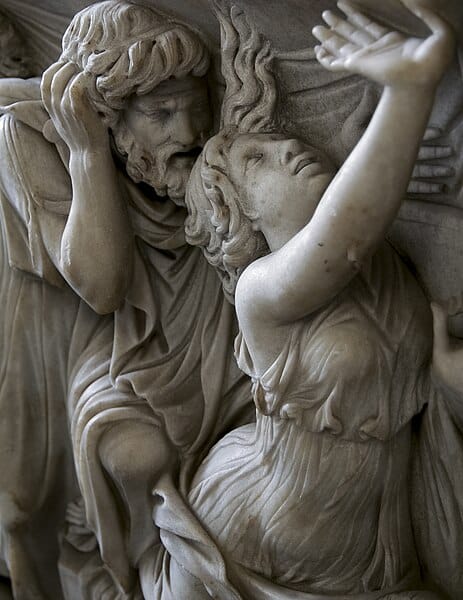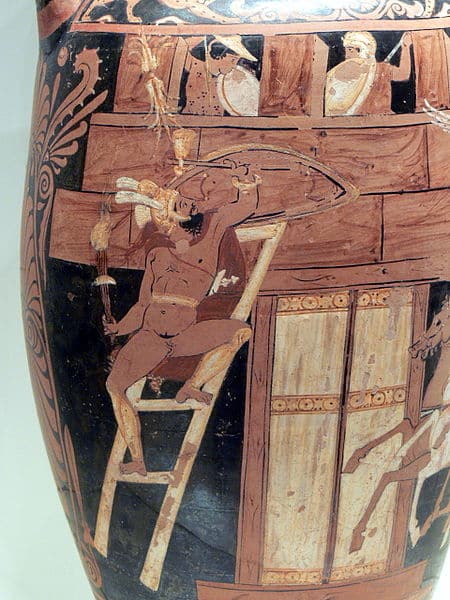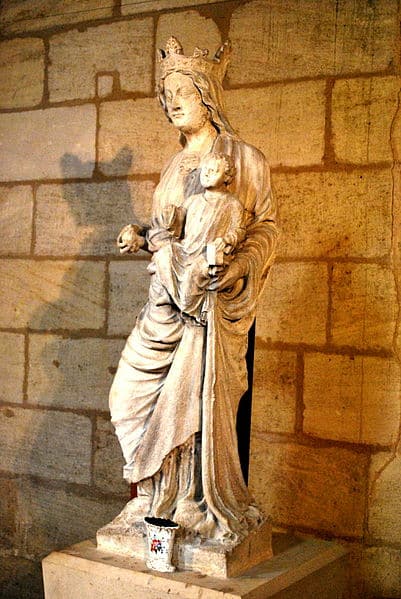In the vast and rich landscape of Greek mythology, King Creon of Thebes emerges as a figure of significant import. His narrative, woven through various myths, reveals a character of complex morality and stern governance. The tale of Creon is not just a solitary narrative but a part of a larger fabric that encompasses the tales of Oedipus, Antigone, and the overarching lore of the city of Thebes. His story, while not as flamboyant as some of his contemporaries, holds a mirror to the intricate dance of duty, loyalty, and the human condition.
Creon’s Key Facts
| Parents | Menoeceus |
| Partners | Eurydice |
| Siblings | Jocasta |
| Offspring | Megareus, Haemon, Lycomedes |
| Other names | None |
| Roman name | Creon |
| Best Known Myth | Antigone’s defiance |
Name and Etymology
The name Creon, derived from the ancient Greek Κρέων, doesn’t carry a specific meaning, a common trait among names of ancient Greek figures. However, the narratives surrounding Creon often highlight his role as a king and a decision-maker, attributes that are integral to his identity. His Roman name remains the same, a testament perhaps to the enduring nature of his tale that transcends the cultural divide between ancient Greece and Rome.
Creon’s narrative doesn’t come adorned with epithets, unlike many of his mythological counterparts. This lack of additional monikers reflects a straightforward, unyielding nature, characteristics that define his rule over Thebes.
The absence of other known names or titles for Creon also underscores a singular focus and consistency in his character across different tales. Unlike figures like Odysseus, whose adventures earned him a myriad of titles, Creon’s narrative remains anchored in his role as a monarch, a stern guardian of Thebes’ law and order.
Creon’s Family and Relationships
Born to Menoeceus, a figure of noble lineage, Creon’s roots are deeply entrenched in the soil of Thebes. His sister, Jocasta, would go on to become a central figure in the tragic tale of Oedipus. The intertwining of their fates with the city they call home is a somber reminder of the inexorable pull of destiny.
Creon’s life wasn’t just bound by the threads of royalty but also by the bonds of matrimony. His union with Eurydice bore him three children: Megareus, Haemon, and Lycomedes. Each of these offspring played roles, albeit tragic, in the unfolding narrative of Creon’s life and rule. Haemon’s love for Antigone, in particular, unveils a facet of Creon’s character hitherto unseen, a clash between the personal and the political, between the heart and the crown.

The narrative doesn’t delve into the early years of Creon’s life, but his adulthood is a testament to the complex interplay of relationships and duty. His interactions with figures like Oedipus, Antigone, and even the heroes of the Trojan War like Menelaus and Agamemnon, paint a picture of a man bound by duty, law, and a stern sense of righteousness.
Myths about Creon
Creon’s tale is one of governance, of stern decisions, and the repercussions thereof. His narrative is intertwined with those of other notable figures of Greek mythology, rendering a multi-dimensional view of his character.
Antigone’s Defiance
The tale of Antigone’s defiance against Creon’s edict is perhaps the most telling of his character. Creon’s decree, forbidding the burial of Antigone’s brother Polynices, sets the stage for a clash of wills that echoes the eternal struggle between personal convictions and the law of the land. Antigone’s bold defiance and Creon’s unyielding stance lead to a tragic end, a somber reflection on the cost of inflexibility.

Creon’s decision, though harsh, was rooted in his duty as a king to uphold the law and ensure order within his realm. However, the tragic fallout reveals the fine line between justice and tyranny, a line easily blurred in the face of rigid adherence to the law. The tale also unveils the personal cost of such unyielding governance, as Creon grapples with the tragic demise of his son Haemon, who sides with Antigone in her quest for familial duty.
The narrative of Antigone’s defiance is not just a tale of right and wrong, but a profound exploration of the human condition, of love, loyalty, and the often unforgiving hand of justice.
Creon and Oedipus
Creon’s interaction with Oedipus, his brother-in-law, and later, his successor to the throne, unveils another facet of his character. His initial support for Oedipus was followed by a reluctant takeover of the throne after Oedipus’ fall from grace. Furthermore highlighting the delicate balance of loyalty, duty, and the inexorable pull of destiny.
The transition from a supporter to a ruler is not a smooth one for Creon. His ascension to the throne in the wake of Oedipus’ tragic end is a somber reminder of the transient nature of power and the heavy burden of governance. The tale also explores the complex dynamics of their relationship, from allies to adversaries, a transformation wrought by the harsh hand of fate.
Creon’s rule, following Oedipus’ abdication, is a period of stern governance, a stark contrast to the tumultuous reign of Oedipus. His decisions, though often harsh, are aimed at restoring order and stability to a city beleaguered by tragedy and discord. Yet, the cost of such stern governance is often personal, a theme that resonates throughout Creon’s narrative.
Depiction And Characteristics
Creon’s depiction in mythology is that of a stern ruler, his countenance often reflecting the heavy burden of the crown. His attire, typically that of a king, is symbolic of his status and the authority he wields. The scepter, a common symbol of kingship, is often associated with Creon, a representation of his rule and the power vested in him.
His personality, as gleaned from the myths, is one of rigidity and a strong sense of duty. His decisions, though often harsh, are rooted in a desire to uphold the law and ensure order. However, this unyielding adherence to duty often puts him at odds with those he holds dear, a tragic theme that resonates throughout his narrative.
The fauna and flora of ancient Greece don’t lend themselves as symbols for Creon, unlike other figures of Greek mythology. His narrative is devoid of the mystical associations that often accompany the tales of gods and heroes. His story is a more somber reflection on the human condition, on the cost of duty, and the often unforgiving nature of governance.
Creon’s character is a complex blend of duty, loyalty, and the stern hand of justice. His narrative, though not as flamboyant as some of his contemporaries, holds a mirror to the intricate dance of governance,. Moreover is dives into the delicate balance of personal relationships, and the often harsh reality of upholding the law.
Representations Of Creon In Art
Creon’s portrayal in art is often one of stern countenance, reflecting the burden of governance and the unyielding nature of his rule. His depiction in the classical Greek style, with a focus on realism and expression, captures the essence of his character, a ruler bound by duty and the law.

One of the notable artworks depicting Creon is his portrayal in the various renditions of the play “Antigone” by Sophocles. The visual representation of Creon in these renditions, often stern and authoritative, captures the essence of his conflict with Antigone, a clash of wills that reflects the broader theme of personal convictions versus the law.
The narrative of Creon also finds expression in modern art, with artists drawing on his tale to explore themes of governance, justice, and the human condition. His story, though ancient, resonates with contemporary audiences, a testament to the enduring nature of his tale and the universal themes it explores.
Mentions in Ancient Texts
Sophocles’ Antigone
Sophocles, in his play “Antigone,” penned around 441 BC, delves into the conflict between Creon and Antigone, a clash of wills that reflects the broader struggle between personal convictions and the law. The quote, “There’s nothing in the world so demoralizing as money,” reflects Creon’s disdain for corruption and his stern adherence to the law, even in the face of personal loss.
Sophocles’ Oedipus Rex
In “Oedipus Rex,” another masterpiece by Sophocles written around 429 BC, Creon’s interaction with Oedipus unveils a complex dynamic of loyalty, duty, and the inexorable pull of destiny. The narrative explores Creon’s reluctant takeover of the throne following Oedipus’ fall from grace, a somber reflection on the transient nature of power and the heavy burden of governance.
Euripides’ Phoenician Women
Euripides, in his play “Phoenician Women” written around 410 BC, explores the complex dynamics of Creon’s rule and his interaction with the beleaguered house of Oedipus. The narrative delves into the tragic fallout of the conflict between the houses of Oedipus and Creon, a somber reflection on the cost of power and the often tragic nature of governance.
Frequently Asked Questions
Creon was a king of Thebes, known for his stern governance and conflicts with Antigone and Oedipus. His tale explores themes of duty, loyalty, and the often harsh reality of upholding the law.
Creon forbade the burial of Polynices as he viewed him as a traitor to Thebes.
Antigone’s defiance led to her death. A tragic outcome that reflects the cost of standing up for personal convictions against the stern hand of governance.
Creon’s rule, characterized by stern governance, aimed at restoring order and stability to Thebes. However, his unyielding adherence to duty often led to personal and political conflicts, reflecting the complex nature of governance.
Creon was initially a supporter of Oedipus but later took over the throne after Oedipus’ fall from grace. Their relationship transformed from allies to adversaries, a transformation wrought by the harsh hand of fate.
Featured Image Credit: Internet Archive Book Images, The Commons, via Wikimedia Commons
